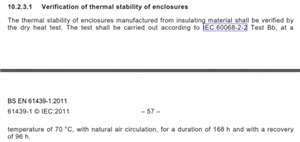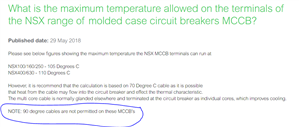Many designers I assume, are not aware and proceed in producing the calculations in Amtech or similar with cables to set operate at 90 degrees and think all is ok.



MG:
Was talking to a switchboard manufacturer and he mentioned that the switchboards manufactured to BS 61439 are only tested to 70 degrees C, so all the cables attached to/from it must be calculated for 70 degrees. The only reference in the standard which makes some sense about this is section 10.2.3.1 attached. This means that all the XLPE cabling out there which is rated at 90 degrees is under-utilised and is useless.
Many designers I assume, are not aware and proceed in producing the calculations in Amtech or similar with cables to set operate at 90 degrees and think all is ok.
I think you may be mixing up 70C with what is actually a temperature rise of 70K above the ambient. The switchboard should not allow the terminals for external conductors to exceed a 70K rise above 20C - ie 90C. Busbars etc can rise to as high as 105C.
The manufacturer is of course at liberty to state a temperature rise less than this for the device to deliver FLC - but I'm pretty certain Schneider don't do this as their ACB's and MCCB are widely used in third party switchgear.
Regards
OMS

We're about to take you to the IET registration website. Don't worry though, you'll be sent straight back to the community after completing the registration.
Continue to the IET registration site